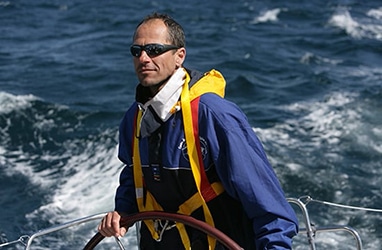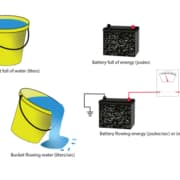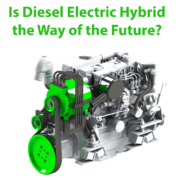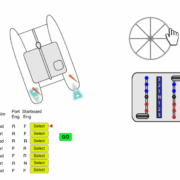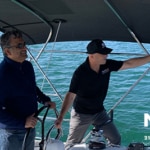Energy on your Boat
Details and tips for understanding energy on your boat
Managing Energy on your boat is like managing water on your boat – there is a limited supply and you have to constantly top it up as you use it.
With the maturity of Lithium-Ion batteries and high capacity storage, people look for smarter and faster ways to generate more energy on your boat. While solar will always be a cheap and easily available source of energy, for today’s modern boat with all the desired creature comforts – such as the array of electronics, refrigeration, electric ovens, water heaters, water makers, air conditioning, and more – solar cannot keep up.
Power vs Energy on your Boat
Energy:
The concept of energy is likened to water for the easiest understanding. A bucket of water holds a specific amount of water that is measured in a number of gallons or liters. It is finite: when it is all drained out, it is gone. To gain more, it must be replaced from a water source.
In the same manner, energy is measured in a quantity like gallons or liters are to water. Energy quantity is measured in joules. The battery itself is likened to the bucket. The battery holds a certain amount of joules of energy and when it is all gone, it is gone. To gain more usable electricity on your boat, you must add more joules back into your battery.

Power:
The concept of power is likened to a quantity of water flowing out of the bucket over time. While draining the bucket of water, the water is flowing out at a certain rate. If a 10-liter bucket drains out in 1 minute, the flow rate out is 10 liters per minute or 600 liters per hour.
Power is the flow rate or usage of energy over time measured in joules of energy per second of time. One joule of energy used every second is one watt of power. Thus, electrical devices are rated in watts – the amount of energy per second the device uses while it is ‘on’. The longer you leave the device on, the greater amount of energy is consumed and drained from your limited resource energy-holding batteries.
To summarize the above: Energy is a quantity, and power is the rate of usage of that energy over time.
When you are on a sailboat on a sailing vacation or cruising, you are the energy manager. As such, you’re going to need to understand the mathematics of it all and constantly do energy audits. When sailing at home, this is rarely an issue because typically at the end of the day you go back home and plug into the shore power to recharge your batteries. When sailing abroad or on extended trips, plugging into shore power rarely happens every night.
To put this all in perspective, a fridge/freezer unit on a sailboat is typically rated at 60 watts. This means that every second it is on and cooling it uses 60 joules of energy. But like a fridge at home, the fridge is not always running. It cools down to the right temperature then the thermostat switches the fridge off. When heat enters in through the walls of the fridge and raises the temperature a few degrees, the fridge turns back on and starts consuming 60 watts of power or 60 joules of energy every second to cool the fridge back down to its thermostat setting – then is switches itself off again.
Let’s say you load the fridge up with warm beer. After 1 hour of full running the fridge would have used:
60 j/sec * 3600 sec/hr * 1 hr = 216,000 joules.
But that number, 216,000 joules really doesn’t mean much. So engineers simplified the concept using watt-hours, which is also a measure of energy (1 watt-hr = 1 joule/sec * 3600 sec/hr = 3600 joules). Since power (the flow rate of energy) is measured in watts, it is more practically meaningful to list energy in watt-hrs instead of joules. i.e. if you use 1 joule per second for 3,600 seconds you would have used 3,600 joules. Since one joule per second is one watt and 3,600 seconds is one hour this is 1 watt.hour (watt.hr). This is not watts per hour – there is no such thing – rather watt.hrs is the flow rate of energy (watts) multiplied by time (hours) and is thus watt.hours – a specific amount of energy used. In water terms, this is like liters/hour (akin to watts) multiplied by time (hours) – which is the amount of liters used.
Tip: Engineers use watt-hrs as the meaningful unit of energy
In this case, the 60-watt fridge/freezer ran for 1 hour and used 60 watt.hrs of energy from the house battery bank. If the fridge/freezer ran on full cooling for 24 hours then it would use:
60 watts x 24 hours = 1440 watt-hours of energy (or 1.44. kilowatt-hrs)
In reality, the fridge does not run 100% of the time (unless loaded with warm stuff). The % of time it runs is called the duty cycle. Assuming the duty cycle is 50% then a full day of running the fridge and keeping the beer (and food) cold consumes 720 watt-hrs or 0.72 kilowatt-hrs of energy.
Battery Capacity Ratings
Unfortunately, someone decided to measure lead-acid battery energy capacity in Amp-hrs. In reality, there is no unit of measurement as an Amp.hr and it drives engineers crazy. Amps need to be multiplied by the voltage to put it into real terms. For example, a 200 Amp.hr battery at 12 volts contains half the amount of energy as a 200 Amp.hr battery at 24 volts. So, Amp.hrs is really a nonsensical measurement of energy.
A more practical energy capacity rating of batteries is in watt.hrs. This allows anyone to easily calculate how long a battery will last at a certain wattage drain rate as the example above with the refrigerator. With the advent of Lithium-Ion batteries, fortunately, the ratings have now been universally listed in watt.hrs – whew. This makes the calculation of amount of available energy easy for the mariner.
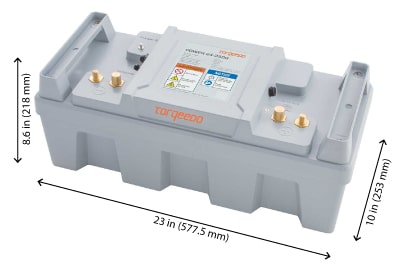
How much energy?
We added up all the energy draws on a typical 40-foot boat with modern amenities. The conclusion was, on average, the boat will use about 5000 watt.hrs of energy per day – this is excluding air conditioning. This makes the math really easy – the 3,500 watt.hr Lithium-Ion battery above fully charged would provide 3500/5000 = 70% of the daily requirement.
When you add in air conditioning, the numbers go crazy. NauticEd performed an experiment on a Beneteau 41 monohull in Caribbean type conditions – 80o F water temperature and 78oair temp at night. The air conditioning thermostat was set at 75o F. It was found that with 4 people sleeping onboard, the amount of energy consumed was 1,400 watt.hrs per hour. For a 10 hour evening using air conditioning, this means that 14,000 watt.hrs of energy would be consumed just for air conditioning. That is a lot: 4 of the lithium-ion batteries above!
Sources of Energy
Solar: Solar panels are conveniently and properly rated in watts – Joules of energy converted from sun energy per second to electrical energy. And actually, they are really rated in watts per square meter. The best solar panels today can produce about 300 watts per square meter. A big catamaran might have space for an array of about 6 square meters of panels (2m x 3m). This array can produce 300 watts/m2 x 6 m2 = 1800 watts. As a general rule of thumb, on a sunny day, you can multiply this by about 5 hours per day to gain the amount of energy produced. Thus a large array on a catamaran could produce up to about 9000 watt.hrs of energy. A monohull has significantly less available area for mounting solar panels and so 2 square meters is more realistic. This means 300 watt/m2 x 2 m2 x 5 hrs = 3000 watt.hrs per day can be produced from solar.
Thus while solar is capable of taking a big dent out of the energy used per day, if you add in air conditioning, solar can not keep up. You have to get more energy from other sources.

Alternator: An alternator does not produce very much energy despite it being connected to the engine. This is mostly because of the limited “dumb” electronics in the alternator such as the diode. An alternator will produce about 800 watts of energy. For every hour of engine run time, you only generate 800 watt.hrs which is not enough even if running the engine for 3 hours (2400 watt.hrs).
Generator: A generator onboard your boat can be a major source of energy. A typical marine generator that will fit on a 45-foot monohull provides up to 8,000 watts. This can keep up with the peak load of all air conditioners running at full speed as well as all your electronics. Generators are heavy and expensive to buy and operational maintenance is also expensive. Essentially, a generator is just another diesel engine that has an electrical generating device attached to it. It has soundproofing around it to lessen the noise, but if you’re running air conditioning from your generator, you’re going to be listening to the thrumb all night (as well as your neighbors).

High Output Alternators: Some alternators have been designed to output a large amount of energy as much as 3000 watts. However, these alternators have developed a reputation for being unreliable and often the diodes blow from surges of energy when throttling the propulsion engine up and down as you maneuver in a marina.
Intelligent Alternators (Integrel): Several attempts at smart alternators have been done which draw power off the front pulley via a large belt with a very stiff tensioner. One such is the Integrel device which NauticEd originally endorsed due to its innovation. However, Integrel has proven to be not reliable over time because of belt wear and breakage, high loads on the alternator bracket leading it to bend, as well as fatigue loads on the bracket bolts. Additionally, constant issues with the complex software lead to many installation problems costing many thousands of dollars to the installer and further ongoing operational problems to the user. The issue with Integrel really comes down to trying to pull too much energy off the front pulley. Consequently, the engine manufacturers have denied warranty coverage. Integrel is made by Triskel Marine in the UK – a small start-up company that did have a great idea but failed to implement it properly. Our advice is to stay away from the Integrel – there are other more innovative devices coming like hybrid engine/generators. See this article on why Integrel did not work.
Hybrid Engine/Generators: These are going to be seen more and more on sailboats and powerboats and seemingly are the ultimate solution.
The parallel hybrid system makes use of the high power available from the drive shaft driven by the diesel propulsion engine. Between the engine and the propeller, a smart clutch/gearbox is inserted. The clutch can send mechanical power to the propeller as well as to an electric generator. The electric generator creates electricity and stores it in a 48-volt bank of batteries for later usage. What is clever about this system is that the electric generator can double as an electric motor, so now if the 48-volt bank of batteries are full and the mariner decides to run their boat propulsion on electricity, they can switch off the diesel engine and allow the electric motor to drive the propeller through the clutch/gearbox.
The design below is supplied by Hybrid Marine
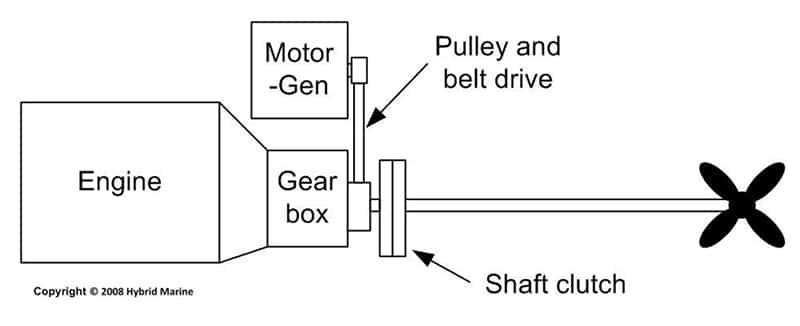
For further understanding on this particular product from Hybrid Marine, although there are other manufacturers out there. NauticEd has no relationship with Hybrid Marine and can not speak regarding their exact technology but does recognize that two major boat manufacturers, Antares Catamarans and HH Catamarans, are using their technology.
The 48-volt bank of batteries charged from the motor/generator also doubles as a large storage of energy for use onboard for air conditioners, refrigerators, and boat electronics, etc.
The smart mariner then just makes decisions about his stored electrical energy and runs the diesel or electric motor as appropriate. When at anchor, if there is not enough energy in the 48-volt bank, electricity can easily be made from the main engine through the electric generator.
This hybrid system completely eliminates the traditional generator which is just another diesel engine onboard with associated weight and cost.
Using the hybrid system will allow the mariner to generate a huge amount of electrical energy very quickly and store it in Lithium-ion batteries. For example, if a catamaran uses 20 kW.hrs of energy for its air conditioning on a night, this amount of energy could be generated in 2 hours of dual engine run time as opposed to running a generator all night long. Add solar and you can cut that in half. Electrical energy can also be generated while using the spare available energy from the propulsion engines even while maneuvering in gear.
Wind Turbines: Manufacturers rate their turbines for 28 knots of wind speed. But power output from wind turbines decreases by the 3rd mathematical power with wind speed. So if you half 28 knots to 14 knots, an impressive-sounding 400 watt rated wind turbine can only produce 50 watts.
Water flow generators: As water flows over the propeller while the boat is sailing which turns the propeller. This can be harnessed into electrical energy. Many hybrid systems as above have this capability built into their system. While this adds to your incoming energy, it relies on you sailing (a lot).
Inverters and Converters
An inverter is not really a source of energy on your boat. It changes electric stored energy in batteries into 110 vAC or 220 vAC (alternating current) energy. AC is what your larger appliances run on such as a microwave and is the same as you have in your house. Thus to run AC appliances from your batteries, you need an inverter. Inverters are rated in watts (the amount of watts should be greater than the appliances you want to connect).
You can get a large inverter that is permanently mounted into your boat for running such devices as microwaves or a smaller portable inverter that will create a small amount of 110v/220v current for charging laptops and the like.
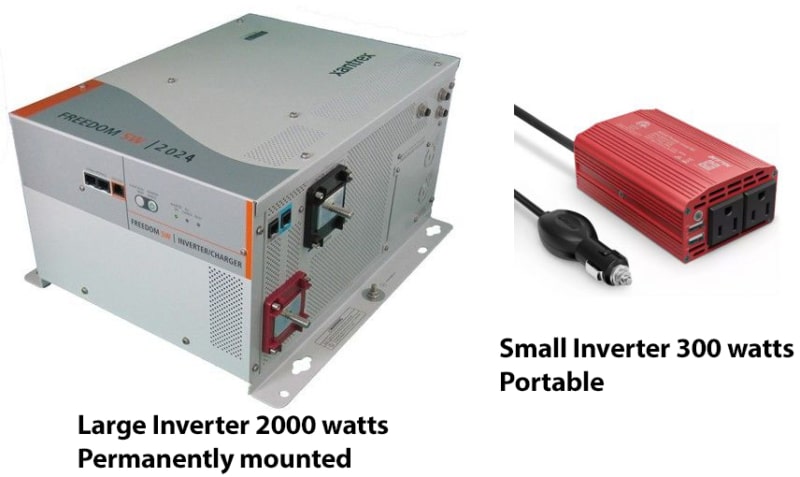
Similarly but opposite, a converter converts AC electricity into DC electricity. An example is the battery charger which takes electricity from the shore power or from the generator and uses it to charge the batteries. Additionally, a converter can change one DC voltage to another DC voltage – e.g. 48vDC down to 12vDC.
And just for completeness, a transformer changes from one AC voltage to another – e.g. 220vAC down to 110vAC or 110vAC up to 220vAC. You find these on boats that are world cruisers moving between continents and countries.
Conclusion
Running out of energy on your boat sucks. It will mean warm drinks, food going off in the warm refrigerator, navigation equipment going down, and worse. The prudent captain will monitor and manage energy usage just like drinking water on the boat. Training your crew to be energy conservative is a good idea. Air conditioning is the biggest energy drain so try to use natural cooling like wind scoops.
Lithium-Ion batteries are a technology gift to the marina but efficient ways of topping up those batteries need to be considered such as solar and hybrid engine/generator systems.

